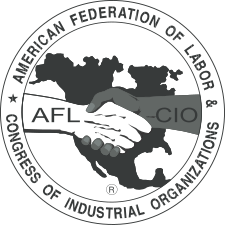
Back الاتحاد الأمريكي للعمل ومؤتمر المنظمات الصناعية Arabic Амерыканская федэрацыя працы — Кангрэс вытворчых прафсаюзаў Byelorussian American Federation of Labor and Congress of Industrial Organizations German AFL-CIO Esperanto AFL-CIO Spanish Ameerika Tööföderatsioon – Tööstusorganisatsioonide Kongress Estonian فدراسیون کارگران آمریکا و کنگره سازمانهای صنعتی Persian AFL-CIO Finnish Fédération américaine du travail - Congrès des organisations industrielles French AFL-CIO Galician
American Federation of Labor and Congress of Industrial Organizations | |
 | |
| Formation | December 5, 1955 |
|---|---|
| Merger of | |
| Type | Trade union center |
| Headquarters | Washington, DC, US |
| Location |
|
Membership (2022) | 12,471,480[1] |
President | Liz Shuler |
Secretary-treasurer | Fred Redmond |
| Secessions | Change to Win Federation |
| Affiliations | International Trade Union Confederation |
| Website | aflcio |
The American Federation of Labor and Congress of Industrial Organizations (AFL-CIO) is a national trade union center that is the largest federation of unions in the United States. It is made up of 60 national and international unions,[2] together representing more than 12 million active and retired workers.[1] The AFL-CIO engages in substantial political spending and activism, typically in support of progressive and pro-labor policies.[3]
The AFL-CIO was formed in 1955 when the American Federation of Labor and the Congress of Industrial Organizations merged after a long estrangement. Union membership in the US peaked in 1979, when the AFL-CIO's affiliated unions had nearly twenty million members.[4] From 1955 until 2005, the AFL-CIO's member unions represented nearly all unionized workers in the United States. Several large unions split away from AFL-CIO and formed the rival Change to Win Federation in 2005, although a number of those unions have since re-affiliated, and many locals of Change to Win are either part of or work with their local central labor councils. The largest unions currently in the AFL-CIO are the American Federation of Teachers (AFT) with approximately 1.7 million members,[5] American Federation of State, County and Municipal Employees (AFSCME), with approximately 1.4 million members,[6] and United Food and Commercial Workers with 1.2 million members.[7]
- ^ a b US Department of Labor, Office of Labor-Management Standards. File number 000-106. Report submitted September 28, 2022.
- ^ "AFL-CIO". aflcio.org. AFL-CIO. March 2, 2023. Archived from the original on November 3, 2023. Retrieved March 2, 2023.
- ^ Timothy J. Minchin, Labor under Fire: A History of the AFL–CIO Since 1979 (U of North Carolina Press, 2017).
- ^ Jillson, Cal (July 2007). American Government: Political Change and Institutional Development. Psychology Press. ISBN 978-0415960779.
- ^ US Department of Labor, Office of Labor-Management Standards. File number 000-012. Report submitted September 28, 2020.
- ^ US Department of Labor, Office of Labor-Management Standards. File number 000-289. Report submitted March 30, 2021.
- ^ US Department of Labor, Office of Labor-Management Standards. File number 000-056. Report submitted March 25, 2021.